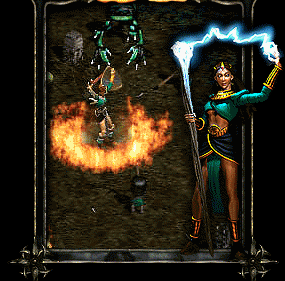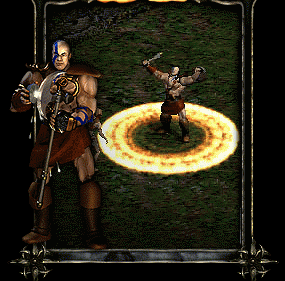|
Quite an interesting game isnt it ? If you want to read no then
go ahead. Otherwise, you can always see the overall
results...end of story ! :-) YPu can also check out the Diablo
2 Screenshots.
 Along
with the newfound variety in territory and quest availability comes
new possibilities in character selection. Instead of the standard
three characters -- four, if you purchased Hellfire -- from the
original, you are now able to choose from a whopping five different
types to do your bidding in the war-torn world of Sanctuary. Returning
in somewhat modified form is the Rogue, known this time around as
the Amazon. Though she is equally adept with the bow as her counterpart,
the Amazon has the added ability to manipulate spears and throwing
weapons with considerable skill and accuracy. The Warrior also returns
in a somewhat distorted fashion, as the battle-hungry Barbarian
emerges onto the scene. Far more primal and physical than their
comrades-in-arms, Barbarians can call upon the very essence of nature
to enhance their strength-driven abilities. As you would expect,
the traditional magic user returns once more, but instead as an
Elementally-charged female Sorceress rather than the previously
male character. This isn't to say that the magical realm is devoid
of male personalities, as the Necromancer makes his debut. Specializing
in death magic, as you would expect, this individual dedicates much
of his time to cursing his foes while recruiting the undead to do
his bidding. This is a stark contrast with the final character type,
the law-abiding Paladin, whose holy nature allows him to draw upon
highly beneficial Auras and other such virtuous magic to implement
his will. As each of these characters possess a different set of
skills and abilities, the strategies needed to safeguard them from
Evil will vary, lending a considerably different feel to each. Along
with the newfound variety in territory and quest availability comes
new possibilities in character selection. Instead of the standard
three characters -- four, if you purchased Hellfire -- from the
original, you are now able to choose from a whopping five different
types to do your bidding in the war-torn world of Sanctuary. Returning
in somewhat modified form is the Rogue, known this time around as
the Amazon. Though she is equally adept with the bow as her counterpart,
the Amazon has the added ability to manipulate spears and throwing
weapons with considerable skill and accuracy. The Warrior also returns
in a somewhat distorted fashion, as the battle-hungry Barbarian
emerges onto the scene. Far more primal and physical than their
comrades-in-arms, Barbarians can call upon the very essence of nature
to enhance their strength-driven abilities. As you would expect,
the traditional magic user returns once more, but instead as an
Elementally-charged female Sorceress rather than the previously
male character. This isn't to say that the magical realm is devoid
of male personalities, as the Necromancer makes his debut. Specializing
in death magic, as you would expect, this individual dedicates much
of his time to cursing his foes while recruiting the undead to do
his bidding. This is a stark contrast with the final character type,
the law-abiding Paladin, whose holy nature allows him to draw upon
highly beneficial Auras and other such virtuous magic to implement
his will. As each of these characters possess a different set of
skills and abilities, the strategies needed to safeguard them from
Evil will vary, lending a considerably different feel to each.
Perhaps the most significant addition to the mix is that of the
skill system. Instead of possessing pre-determined innate abilities
or purchasing spell books, as was the case in the original Diablo,
each individual has access to three character-specific skill trees,
which grow and expand according to your decisions and existing abilities.
The Paladin, for instance, may invest in Combat Skills, as well
as Offensive and Defensive Auras. If he wishes to use the Meditation
skill of the Defensive Aura tree, he must already be able to use
Prayer, Cleansing, and be of a certain level. Along the same lines,
the Necromancer may choose from Curses, Poison and Bone Spells,
and Summoning Spells; can only call upon the Iron Golem if he's
attained Level 24 and has already researched the Clay and Blood
Golems. Constantly casting spells could prove to be a severe drain
on one's mana stores if it were the only way to activate skills,
but fortunately there are several modes that each possess their
own benefits and drawbacks. For example, active skills such as the
Sorceress' Fire Bolt must be cast in order to use, thereby using
up a certain amount of mana. Passive skills, such as the Amazon's
Critical Strike, are constantly active without needing to be cast
nor requiring any mana. The Paladin's unique Auras function much
in the same manner, imbuing himself and all who travel with him
with the appropriate elemental resistance or radiant ability when
activated. Necromantic Curses also function in this manner, affecting
surrounding foes with negative effects, rather than benefiting grouped
allies. Despite the immeasurable value that the skill trees add
to each character, it's extremely important to consider your investments,
as only one skill point is attributed per level, either leaving
you to upgrade an existing skill or to branch off and select a new
one. Such decisions can completely alter the course of your adventuring,
and thus require careful thought before puttingthem into action.
The hunt for bigger, better and more potent items was part of the
original Diablo's appeal, a fact not lost on Blizzard. Consequently,
a great many more items and item types have been integrated into
the sequel for discovery by curious and ambitious adventurers. As
expected, there are the "standard" Magic Items, which
are considered to be the most common of the bunch, and consequently
offer a moderate to good benefit, such as an added bonus to attack,
defense, or statistics. There are also the intermediate Rare Items,
which are much more obscure and powerful than the Magic Items, as
each contains a minimum of three added benefits. Additionally, for
the divinely fortunate, there are the Unique Items, creations of
immeasurable power that are the envy of all those who behold them.
Such items possess several separate benefits of considerable importance,
and can be sold to vendors for an incredibly large sum.
 New
to the series are the surpassingly hard to find Sets, which contain
three or more themed items which complement one another. For example,
the Vidala's Rig set consists of an amulet, leather armor, light
plated boots and a long battle bow, respectively titled Vidala's
Snare, Vidala's Ambush, Vidala's Fetlock and Vidala's Barb. Although
Vidala's Fetlock, which provides you with a quicker running ability
as well as a 150-point bonus to your stamina, is impressive in itself,
it works considerably better when combined with Vidala's Ambush,
which increases your defense by 50 points and your dexterity by
11. Altogether, the set would be well-suited for a fleet-footed,
high-damage Amazon, and as such provides a very unique and distinct
goal to strive for. New
to the series are the surpassingly hard to find Sets, which contain
three or more themed items which complement one another. For example,
the Vidala's Rig set consists of an amulet, leather armor, light
plated boots and a long battle bow, respectively titled Vidala's
Snare, Vidala's Ambush, Vidala's Fetlock and Vidala's Barb. Although
Vidala's Fetlock, which provides you with a quicker running ability
as well as a 150-point bonus to your stamina, is impressive in itself,
it works considerably better when combined with Vidala's Ambush,
which increases your defense by 50 points and your dexterity by
11. Altogether, the set would be well-suited for a fleet-footed,
high-damage Amazon, and as such provides a very unique and distinct
goal to strive for.
If Sets prove too elusive, however, there are more attainable goals
to pursue within the realm of Socketed Items. Another newcomer,
such items are no-frills, non-magical objects such as helms, shields
or weapons that possess open holes or "sockets," in which
gems may be inserted for additional benefit. Although Socketed Items
aren't difficult to find, the gems that are required to enhance
them certainly are, and range in quality from chipped, flawed, normal,
and flawless, to perfect. The item which they are inserted into
is also a relevant factor, as a normal diamond slipped into a weapon
will imbue said weapon with a 136- to 145 percent damage bonus,
whereas it will give a 20-point attack bonus when inserted into
a helm, and a 9- to 11-point bonus to all elemental resistances
when slotted into a shield. Although initially unimpressive, these
benefits can grow to levels of considerable power as one progresses
and discovers gems of increasing quality. However, the question
still has not been answered: Is Diablo II entertaining enough to
be worth all the trouble?
|

